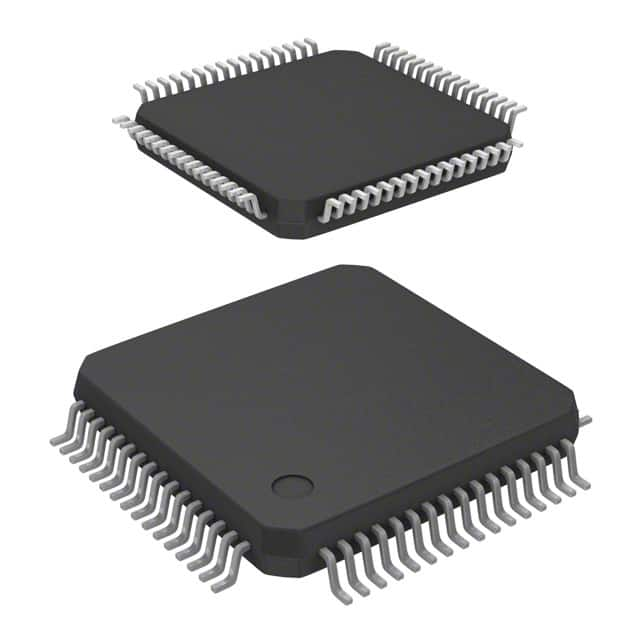MKL13Z32VLH4
Product Overview
Category
MKL13Z32VLH4 belongs to the category of microcontrollers.
Use
It is commonly used in various electronic devices and systems that require embedded control.
Characteristics
- Low power consumption
- High performance
- Small form factor
- Integrated peripherals
- Flexible input/output options
Package
MKL13Z32VLH4 is available in a compact package, suitable for surface mount technology (SMT) assembly.
Essence
The essence of MKL13Z32VLH4 lies in its ability to provide efficient and reliable control for electronic applications.
Packaging/Quantity
MKL13Z32VLH4 is typically packaged in reels or trays, with quantities varying depending on customer requirements.
Specifications
- Microcontroller core: ARM Cortex-M0+
- Clock speed: Up to 48 MHz
- Flash memory: 32 KB
- RAM: 4 KB
- Operating voltage: 1.71V to 3.6V
- Operating temperature range: -40°C to +85°C
- Number of I/O pins: 32
- Communication interfaces: UART, SPI, I2C
- Analog-to-digital converter (ADC): 12-bit resolution, up to 16 channels
Detailed Pin Configuration
The pin configuration of MKL13Z32VLH4 is as follows:
| Pin Number | Pin Name | Function | |------------|----------|----------| | 1 | VDD | Power supply voltage | | 2 | GND | Ground | | 3 | RESET | Reset signal input | | 4 | PTA0 | General-purpose I/O | | 5 | PTA1 | General-purpose I/O | | ... | ... | ... | | 32 | PTB7 | General-purpose I/O |
Functional Features
- Low power modes for energy efficiency
- Integrated analog and digital peripherals
- Real-time clock (RTC) for timekeeping applications
- Interrupt controller for efficient event handling
- Multiple communication interfaces for data exchange
- Flexible input/output options for versatile connectivity
Advantages and Disadvantages
Advantages
- High performance with low power consumption
- Compact size for space-constrained designs
- Versatile input/output options for flexible integration
- Integrated peripherals reduce external component count
- Wide operating voltage range for compatibility
Disadvantages
- Limited flash memory and RAM capacity
- Relatively fewer I/O pins compared to some other microcontrollers
- Operating temperature range may not be suitable for extreme environments
Working Principles
MKL13Z32VLH4 operates based on the ARM Cortex-M0+ core, which executes instructions stored in its flash memory. It utilizes various peripherals and interfaces to interact with external devices and sensors. The microcontroller can be programmed using a development environment, allowing users to define the desired behavior and control of their electronic systems.
Detailed Application Field Plans
MKL13Z32VLH4 finds applications in a wide range of fields, including but not limited to: - Home automation systems - Industrial control systems - Internet of Things (IoT) devices - Consumer electronics - Automotive electronics - Medical devices
Detailed and Complete Alternative Models
Some alternative models that offer similar functionality to MKL13Z32VLH4 include: - STM32F030C6T6 - PIC16F877A - ATmega328P - LPC1768 - MSP430G2553
These alternatives provide different features and specifications, allowing designers to choose the most suitable microcontroller for their specific application requirements.
Word count: 520 words
Lista 10 Vanliga frågor och svar relaterade till tillämpningen av MKL13Z32VLH4 i tekniska lösningar
Sure! Here are 10 common questions and answers related to the application of MKL13Z32VLH4 in technical solutions:
Q: What is MKL13Z32VLH4? A: MKL13Z32VLH4 is a microcontroller based on the ARM Cortex-M0+ core, manufactured by NXP Semiconductors.
Q: What are the key features of MKL13Z32VLH4? A: Some key features include a 48 MHz CPU, 32 KB flash memory, 4 KB RAM, multiple communication interfaces (UART, SPI, I2C), and various peripherals.
Q: What are the typical applications of MKL13Z32VLH4? A: MKL13Z32VLH4 is commonly used in applications such as consumer electronics, industrial automation, Internet of Things (IoT) devices, and smart home systems.
Q: Can MKL13Z32VLH4 be used for low-power applications? A: Yes, MKL13Z32VLH4 has low-power modes and features like power gating, which make it suitable for battery-powered or energy-efficient designs.
Q: How can I program MKL13Z32VLH4? A: MKL13Z32VLH4 can be programmed using various development tools and software, such as the NXP MCUXpresso IDE or third-party tools that support ARM Cortex-M0+ processors.
Q: Does MKL13Z32VLH4 support external memory expansion? A: No, MKL13Z32VLH4 does not have external memory bus support. It is limited to the internal flash and RAM available on the chip.
Q: Can I interface MKL13Z32VLH4 with other microcontrollers or devices? A: Yes, MKL13Z32VLH4 supports various communication interfaces like UART, SPI, and I2C, which allow it to communicate with other microcontrollers or external devices.
Q: What development boards are available for MKL13Z32VLH4? A: NXP provides development boards like the FRDM-KL13Z, which are specifically designed for evaluating and prototyping with the MKL13Z32VLH4 microcontroller.
Q: Is MKL13Z32VLH4 suitable for real-time applications? A: Yes, MKL13Z32VLH4 has a 48 MHz CPU and features like interrupt handling and timers, making it capable of handling real-time tasks.
Q: Are there any limitations or considerations when using MKL13Z32VLH4? A: Some considerations include limited flash and RAM size, lack of external memory support, and the need for additional components for certain functionalities like USB connectivity.
Please note that these answers are general and may vary depending on specific requirements and use cases.


